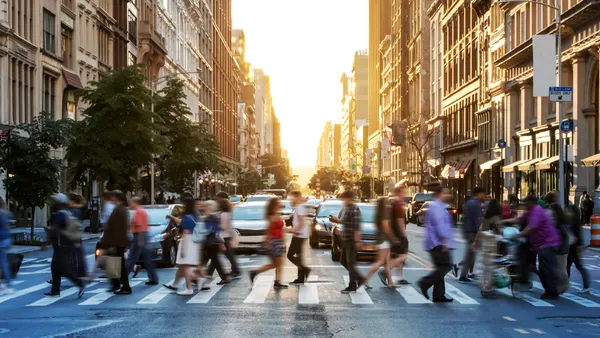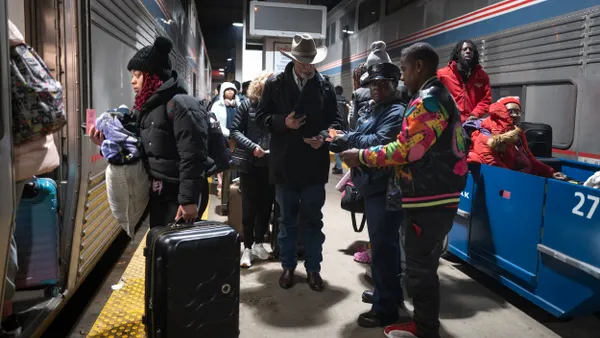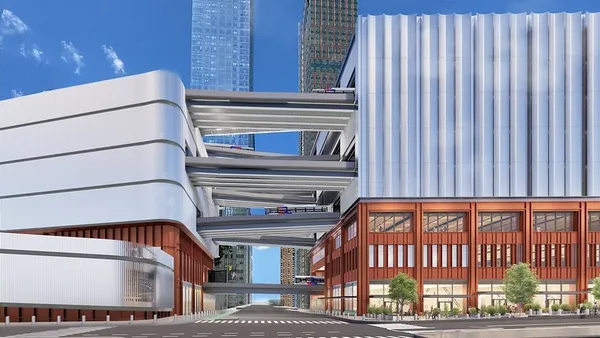Dive Brief:
- StreetLight Data unveiled its first U.S. Transportation Climate Impact Index, which ranks the nation's 100 most populous metro areas on carbon vehicle miles traveled (VMT), mileage of bike and pedestrian commuting, per-capita transit use, population density and circuity.
- The regions at the top of the list are considered the most "carbon-friendly" or low-impact areas. The top five and bottom five metro regions are:
| Top | Bottom |
|---|---|
| 1. New York-Newark, NJ-Jersey City, NJ | 96. Kansas City, MO/KS |
| 2. San Francisco-Oakland, CA-Hayward, CA | 97. St. Louis, MO-East St. Louis, IL |
| 3. Madison, WI | 98. Houston-The Woodlands-Sugar Land, TX |
| 4. Philadelphia-Camden, NJ-Wilmington, DE | 99. Phoenix-Mesa, AZ-Scottsdale, AZ |
| 5. Boston-Cambridge, MA-Newton, MA | 100. Dallas-Fort Worth, TX-Arlington, TX |
- The ranking analyzed commuting trips derived from location-based services (LBS) data. The results are indexed values because "StreetLight does not capture 100% of a city's movements," according to a release.
Dive Insight:
StreetLight Data, which specializes in mobility analytics, developed the index due to the transportation sector's contribution to the growing issue of climate change, according to Vice President of Marketing Martin Morzynski. As cities look to reduce greenhouse gas (GHG) emissions from the transportation sector, StreetLight believes data-driven metrics are most impactful in understanding where to place investments.
The list may come as a shock to some, as New York and San Francisco — which are notorious for congestion — lead the ranking. However, Martin emphasized that the index looked outside those city limits at entire metro regions because of the impact commuters have on GHG emissions.
"A lot of the work that’s been done to-date has tended to focus on the urban core. The notion that dense cities are better environmentally has been around for a long time, because people are closer and we walk and frankly large cities on average, around the world, are viewed as more sustainable," Morzynski told Smart Cities Dive. "The problem is that, particularly in America, these cities are not islands. In San Francisco, the population swells by 30% every day by commuters. So if you can't get those people in efficiently and there's traffic coming in, you really have to look at the metro [region] to understand a city's contribution."
While the index is comprehensive in the number of regions analyzed, it does lack some factors that are part of the holistic mobility and transportation landscape. For instance, the index does not account for scooter rides or weigh the impact of gas-powered vehicles versus electric vehicles (EVs). While Morzynski recognized there are some gaps in the data — primarily due to lack of adoption of such transportation modes, or lack of available data — he said the intention of the index is to show cities the ways they can offset various carbon outputs.
"The climate situation is urgent," Morzynski said. "Transportation is the No. 1 contributor [of GHG emissions] at 30% in this country. No one has been able to-date, because of data limitations, to have a discussion about which modes will move [cities] the furthest along the fastest. We don't have time to sort of beat around the bush. This helps people figure out, how much impact can they have?"
StreetLight hopes planners will analyze the rankings of surrounding metro regions to get a better understanding of how to move up the list. The report offers a breakdown of city rankings by national region, and may soon offer various filters and toggles to make analysis more interactive.
"If I’m Kansas City and I’m able to double down on rail and figure out how much more I can get on a bike, it may very well change the discussion around where I can put my money," Morzynski said. “If I can weigh those, it's instructive on where I can have impact."










